Classification of Acoustic Characteristics of Bubble Flow and Influencing Factors of Critical Gas Flow Velocity
Abstract
1. Introduction
2. Experiment
2.1. Equipment
2.1.1. Water Tank Support System
2.1.2. Data Acquisition System
2.1.3. Flow Monitoring and Gas Supply Pipeline System
2.2. Experimental Materials
2.3. Experimental Method
2.3.1. Sound Signal Noise Reduction
2.3.2. Framed Windowing
2.3.3. Frequency Domain Analysis
3. Results
3.1. Bubble Flow Pattern
3.2. Effect of Surface Tension
3.2.1. The Effect of Surface Tension on the Critical Gas Flow Velocity of Discrete to Single-Chain Bubble Flow Transition
3.2.2. The Effect of Surface Tension on the Critical Gas Flow Velocity of Single- to Dual-Stage Chain Bubble Flow Transition
3.3. The Influence of Dynamic Viscosity
3.3.1. The Effect of Dynamic Viscosity on the Critical Gas Flow Velocity of Discrete to Single-Chain Bubble Flow Transition
3.3.2. The Effect of Dynamic Viscosity on the Critical Gas Flow Velocity of Single- to Dual-Stage Chain Bubble Flow Transition
3.4. The Influence of Orifice Diameter
3.4.1. The Effect of Orifice Diameter on the Critical Gas Flow Velocity of Discrete to Single Bubble Chain Flow Transition
3.4.2. Effect of Orifice Diameter on the Critical Gas Flow Velocity of Single- to Dual-Stage Chain Bubble Flow Transition
3.5. Quantitative Classification of Bubble Flow Pattern
4. Conclusions
- (1)
- Three flow regimes were characterized by their corresponding acoustic signals. In discrete bubble flow, the motion state of preceding bubbles remains independent from subsequent bubbles without mutual influence, while adjacent bubbles exhibit consistent time domain waveforms. In single-chain bubble flow, the time domain diagrams of bubbles demonstrate a stage oscillation. In dual-stage chain bubble flow, the motion state of preceding bubbles exerts a significant periodic influence on subsequent bubbles, leading to distinct differences in time domain waveforms between adjacent bubbles.
- (2)
- The effects of liquid surface tension, dynamic viscosity, and orifice diameter variations on critical gas flow velocities were examined for regime transitions: from discrete bubble flow to single-chain bubble flow, and from single-chain to dual-stage chain bubble flow. The results indicate that surface tension and dynamic viscosity exert a negligible influence on the critical gas flow velocity for the discrete to single chain transition. Increasing orifice diameter reduces this critical value. Conversely, elevated surface tension and dynamic viscosity enhance the critical gas flow velocity from single-chain to dual-stage chain flow, whereas increased orifice diameter diminishes it.
- (3)
- A quantitative classification of bubble flow patterns was established using the Ga and We numbers. This approach provides a universal theoretical framework for flow regime prediction and mass transfer optimization in industrial gas–liquid two-phase flow systems.
Author Contributions
Funding
Data Availability Statement
Conflicts of Interest
Abbreviations
| ρ0 | Density of liquid, kg·m−3 |
| L0 | Orifice diameter, mm |
| V | Gas flow velocity, m·s−1 |
| Σ | Surface tension of liquid, N·m−1 |
| Ga | Galileo number |
| We | Weber number |
| G | Acceleration of gravity, m·s−2 |
| Μ | Dynamic viscosity of liquid, Pa·s |
References
- Liang, J.H.; Fei, Y.; Yin, Y.H.; Han, Q.; Liu, Y.Z.; Feng, L.; Zhang, L.Q. Advancements in wastewater treatment: A comprehensive review of ozone microbubbles technology. Environ. Res. 2025, 266, 120469. [Google Scholar] [CrossRef] [PubMed]
- Quintero-Gonzalez, C.A.; Martinez, J.; Calva-Yanez, J.C.; Oropeza-Guzman, M.T. Physicochemical wastewater treatment improvement by hydrodynamic cavitation nanobubbles. J. Water Process Eng. 2025, 69, 106581. [Google Scholar] [CrossRef]
- Rashid, F.L.; Al-Obaidi, M.A.; Hussein, A.K.; Ahmad, S.; Albdeiri, M.S.; Mujtaba, I.M. Bubble dynamics in sustainable technologies: A review of growth, collapse, and heat transfer. Processes 2024, 13, 38. [Google Scholar] [CrossRef]
- Wang, Z.; Sun, T.; Liu, N. Dispersed phase formation and separation mechanism using high resolution CFD and artificial intelligence technique for simulation of reactors. Chem. Eng. Sci. 2025, 306, 121268. [Google Scholar] [CrossRef]
- Moiz, M.; Prajapat, R.; Srivastava, A.; Srivastava, A. Machine learning-inspired study of dynamical parameters of single vapor bubble under nucleate flow boiling regime. Appl. Thermal Eng. 2025, 259, 124827. [Google Scholar] [CrossRef]
- Lai, K.; Yang, S.L.; Wang, H. Numerical investigation of bubble dynamics and multi-scale flow characteristics in the bottom-blown gas-liquid reactor. Chem. Eng. J. 2023, 474, 145868. [Google Scholar] [CrossRef]
- Qi, H.Y.; Sun, X.Y.; Liu, J.T. Study on acoustic characteristics of bubb1e interaction. IOP Publ. 2024, 2752, 012192. [Google Scholar] [CrossRef]
- Gaurav, K.; Mittal, G.; Karn, A. On the morphology of elongated bubbles during their formation at submerged orifices. Chem. Eng. Sci. 2022, 250, 117395. [Google Scholar] [CrossRef]
- Fattahi, K.; Boffito, D.C.; Robert, E. Quantifying the chemical activity of cavitation bubbles in a cluster. Sci. Rep. 2024, 14, 7978. [Google Scholar] [CrossRef]
- Manasseh, R.; Riboux, G.; Risso, F. Sound generation on bubble coalescence following detachment. Int. J. Multiph. Flow 2008, 34, 938–949. [Google Scholar] [CrossRef]
- Stavrou, V.N.; Tsoulos, I.G.; Mastorakis, N.E. Transformations for FIR and IIR Filters’ Design. Symmetry 2021, 13, 533. [Google Scholar] [CrossRef]
- Stojanovic, N.; Krstic, I.; Stamenkovic, N. Performance analysis of optimum chebyshev filters at microwave frequencies. AEU-Int. J. Electron. Commun. 2024, 187, 8. [Google Scholar] [CrossRef]
- Ali, M.A.; Dhanaraj, R.K.; Nayyar, A. A high performance-oriented AI-enabled IoT-based pest detection system using sound analytics in large agricultural field. Microprocess. Microsyst. 2023, 103, 104946. [Google Scholar] [CrossRef]
- Bojkovic, Z.; Bakmaz, B.; Bakmaz, M. Hamming window to the digital world. Proc. IEEE 2017, 105, 1185–1190. [Google Scholar] [CrossRef]
- Jiang, L.; Zhang, H.J.; Yu, L.; Hua, G. A data-driven high-resolution time-frequency distribution. IEEE Signal Process. Lett. 2022, 29, 1512–1516. [Google Scholar] [CrossRef]
- Qi, H.Y.; Liu, J.T.; Sun, X.Y.; Deng, P.; Zhang, D.M.; Song, Y.X. Investigation of bubble interaction and influence on acoustic signals. Phys. Fluids 2024, 36, 13. [Google Scholar] [CrossRef]
- Tang, J.; Hu, R.; Xu, L.; Liu, H.; Luo, J. Shape oscillation-induced early detachment of bubble from a submerged microcapillary nozzle. Langmuir 2023, 39, 16596–16605. [Google Scholar] [CrossRef]
- Deane, G.; Czerski, H. A mechanism stimulating sound production from air bubbles released from a nozzle. J. Acoust. Soc. Am. 2008, 123, EL126–EL132. [Google Scholar] [CrossRef]
- Babu, R.; Das, M. Effects of surface-active agents on bubble growth and detachment from submerged orifice. Chem. Eng. Sci. 2018, 179, 172–184. [Google Scholar] [CrossRef]
- Gerlach, D.; Biswas, G.; Durst, F.; Kolobaric, V. Quasi-static bubble formation on submerged orifices. Int. J. Heat Mass Transf. 2005, 48, 425–438. [Google Scholar] [CrossRef]
- Islam, M.T.; Ganesan, P.B.; Billah, M.M.; Uddin, M.N. A numerical study of single air bubble formation comparison between in viscous liquid and in water. Asia-Pac. J. Chem. Eng. 2019, 14. [Google Scholar] [CrossRef]
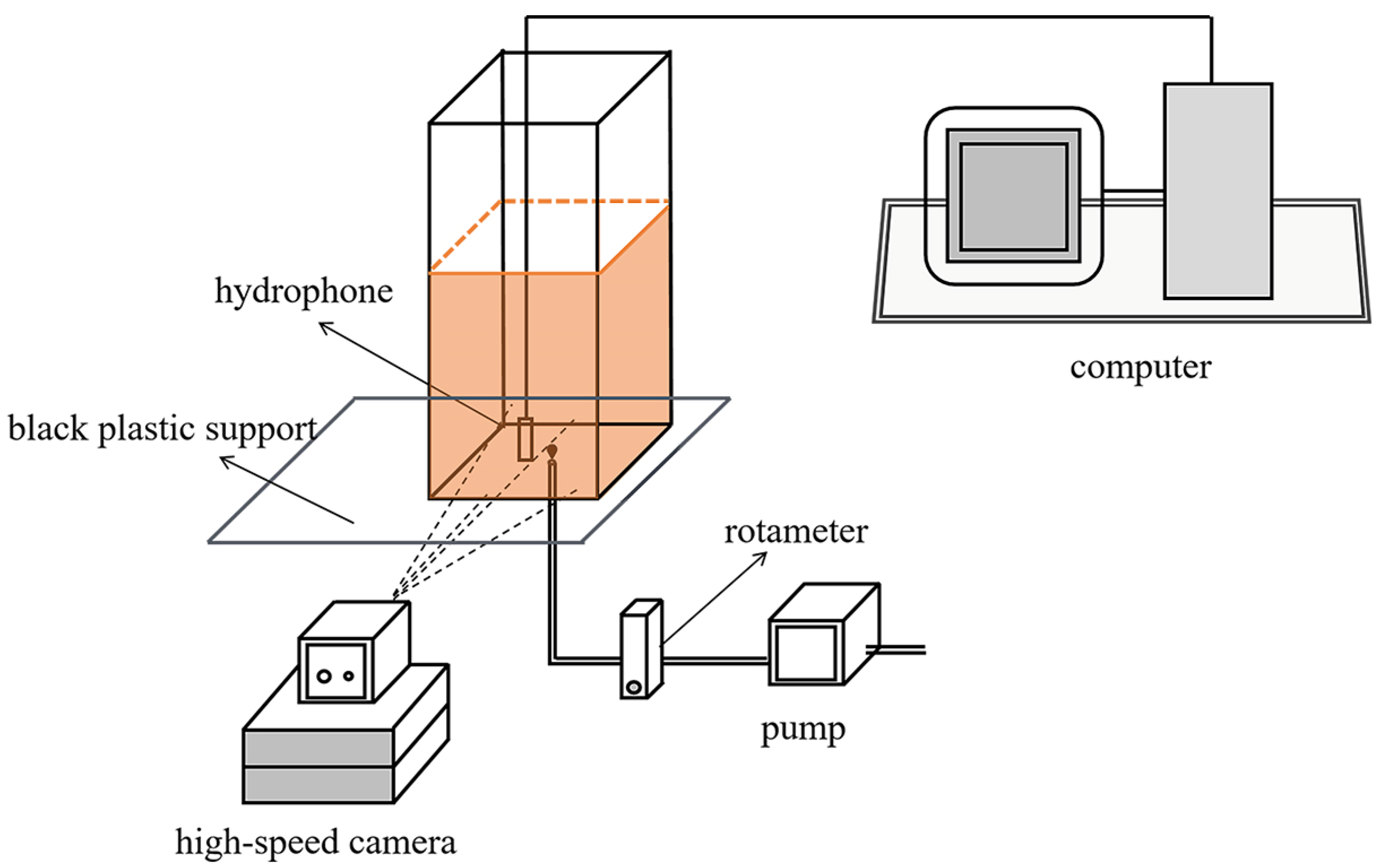
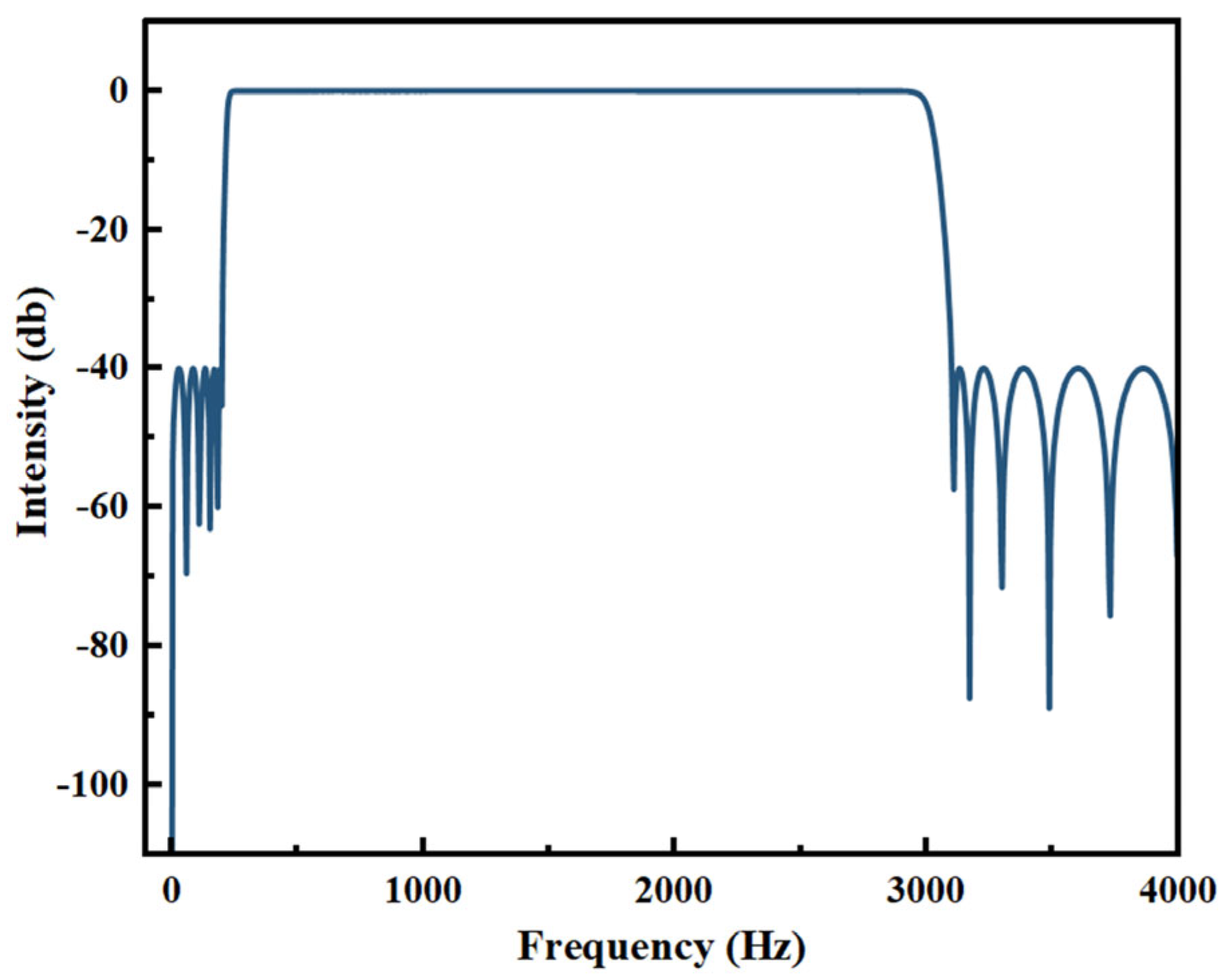
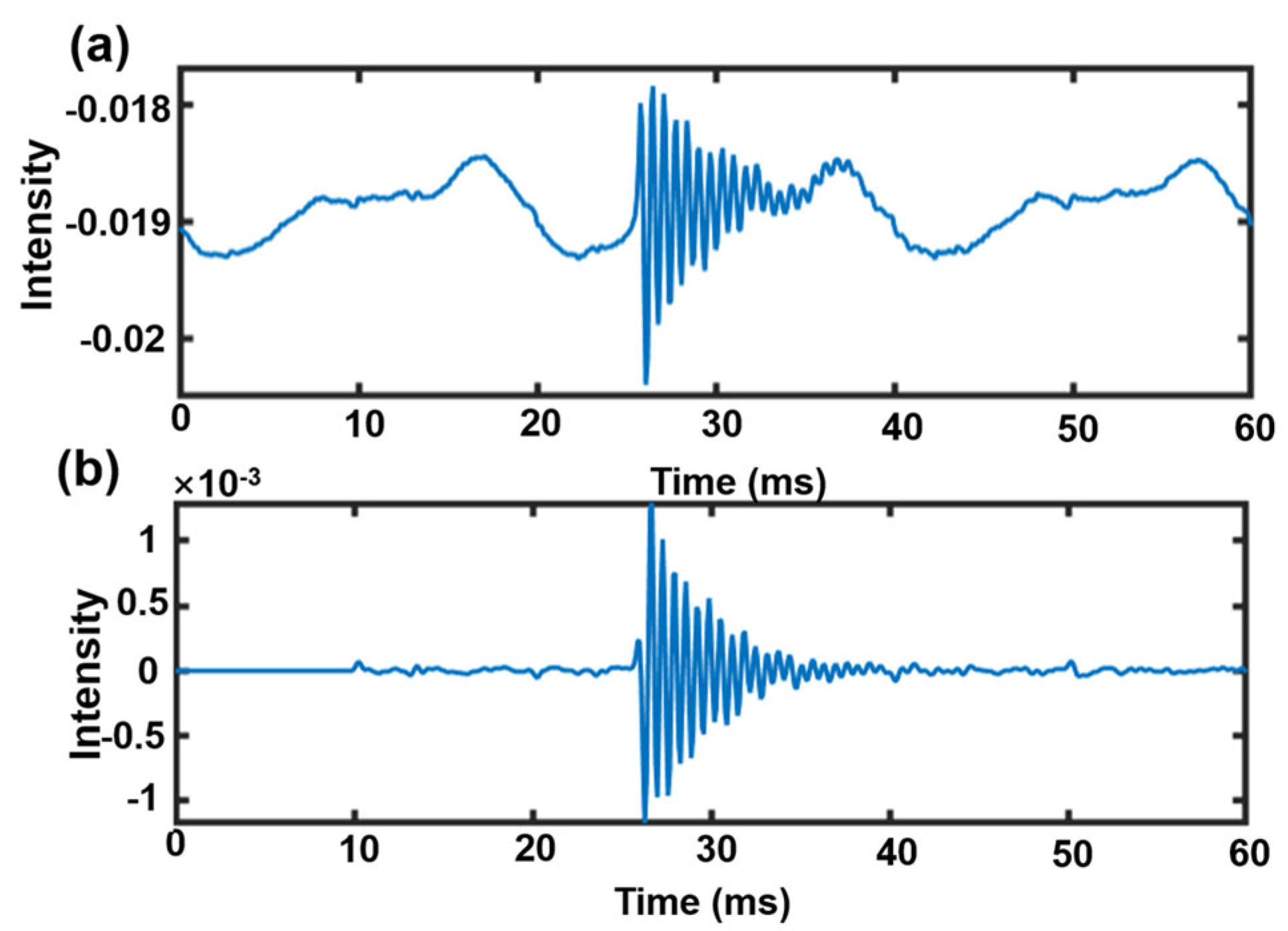
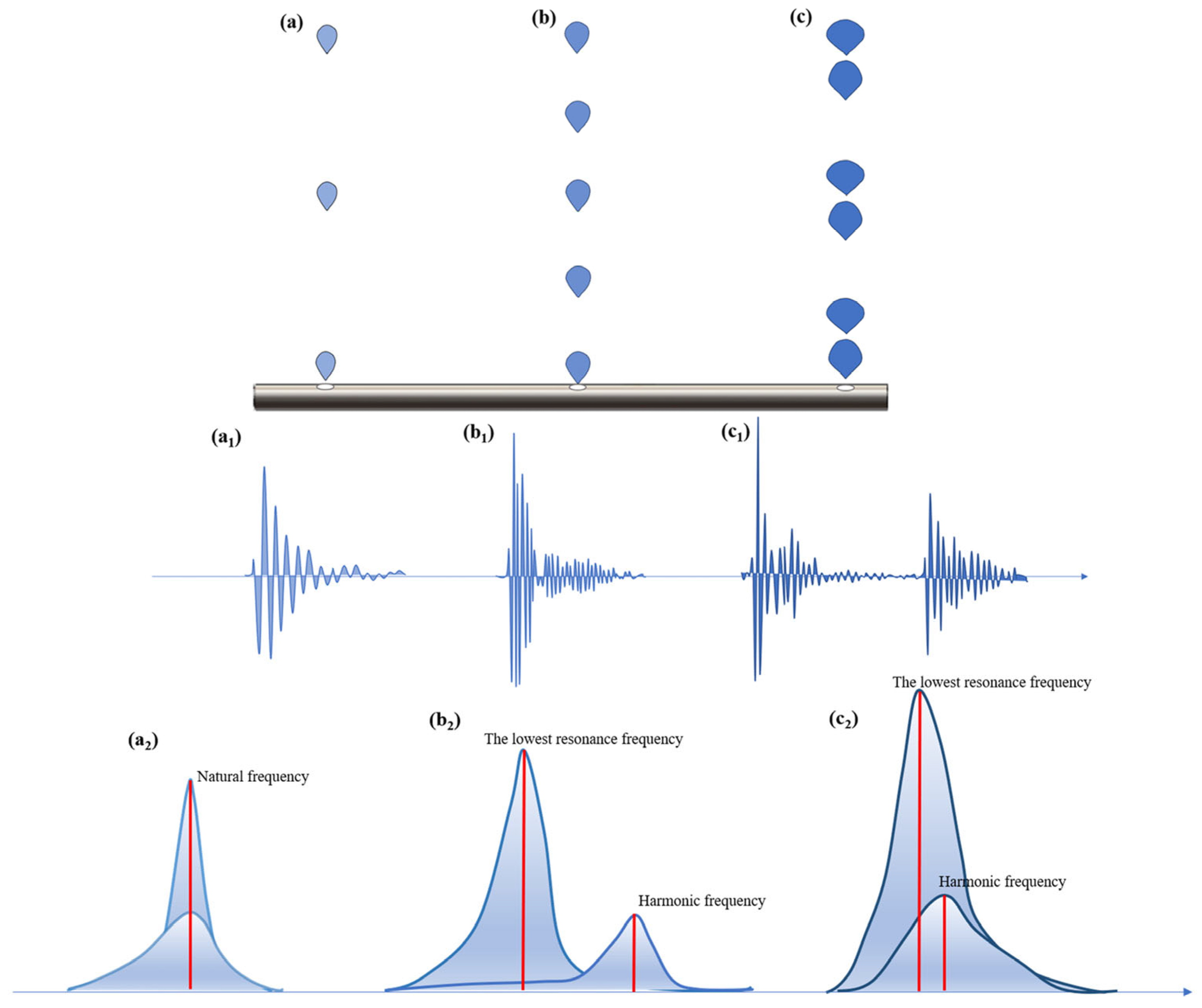
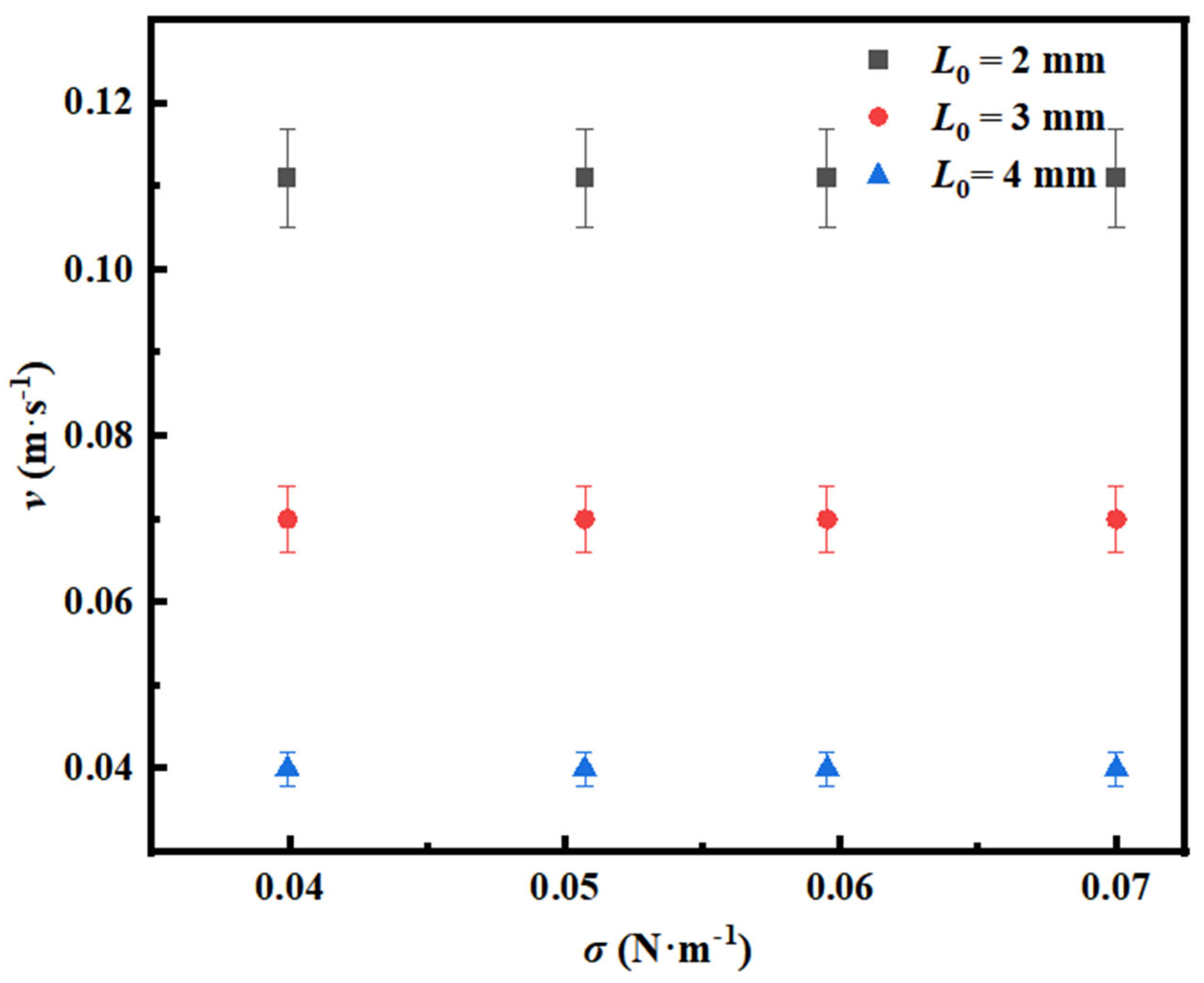


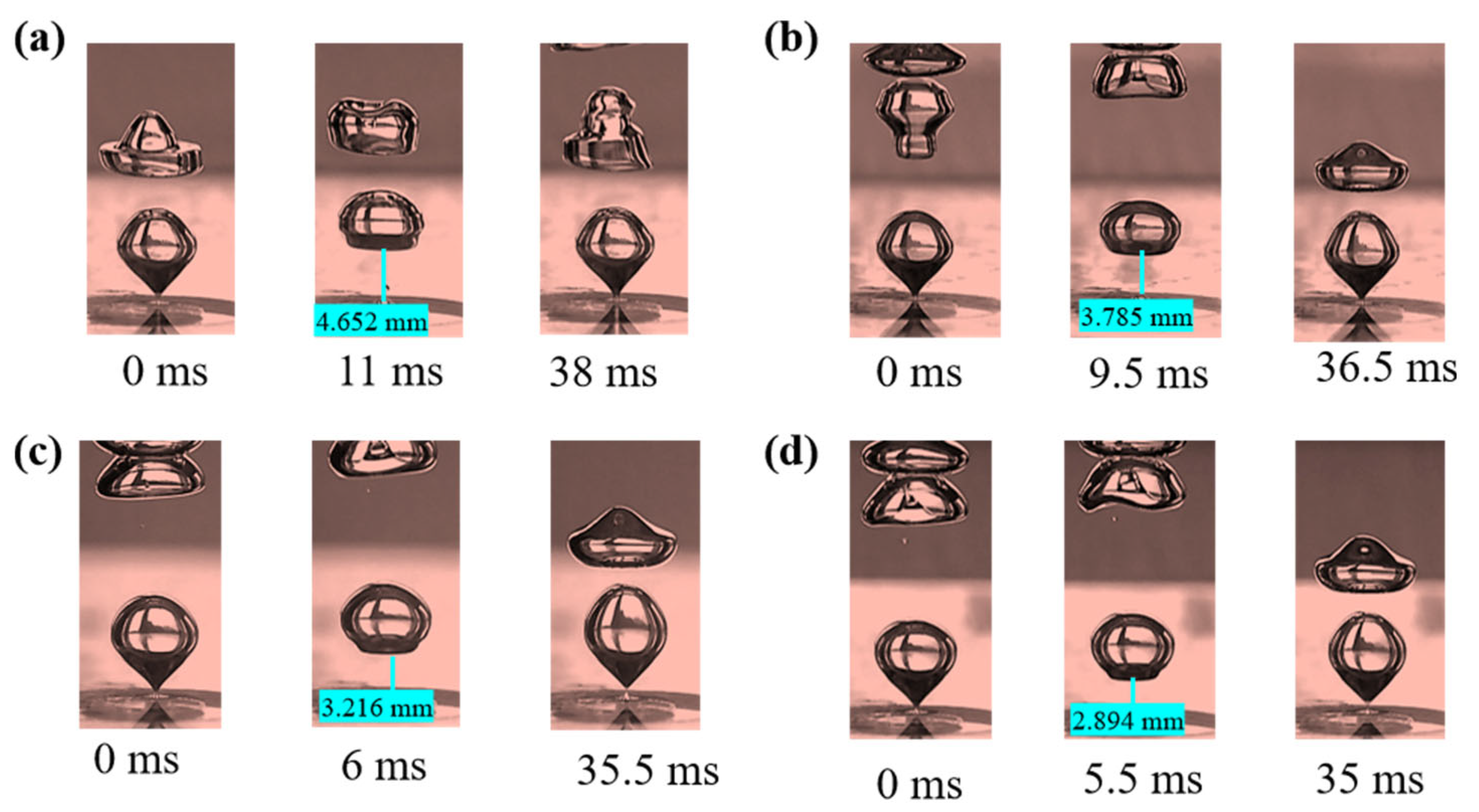
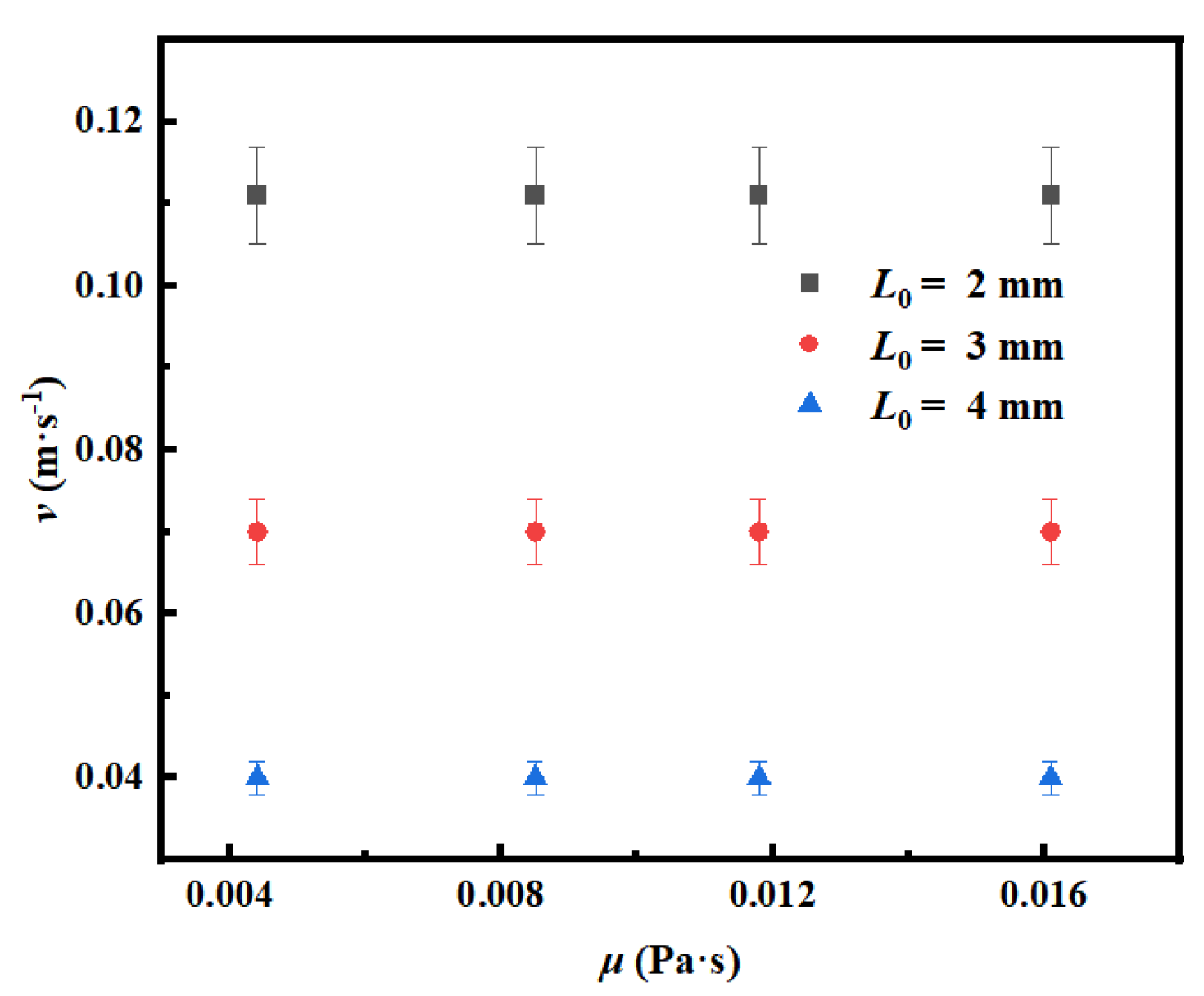
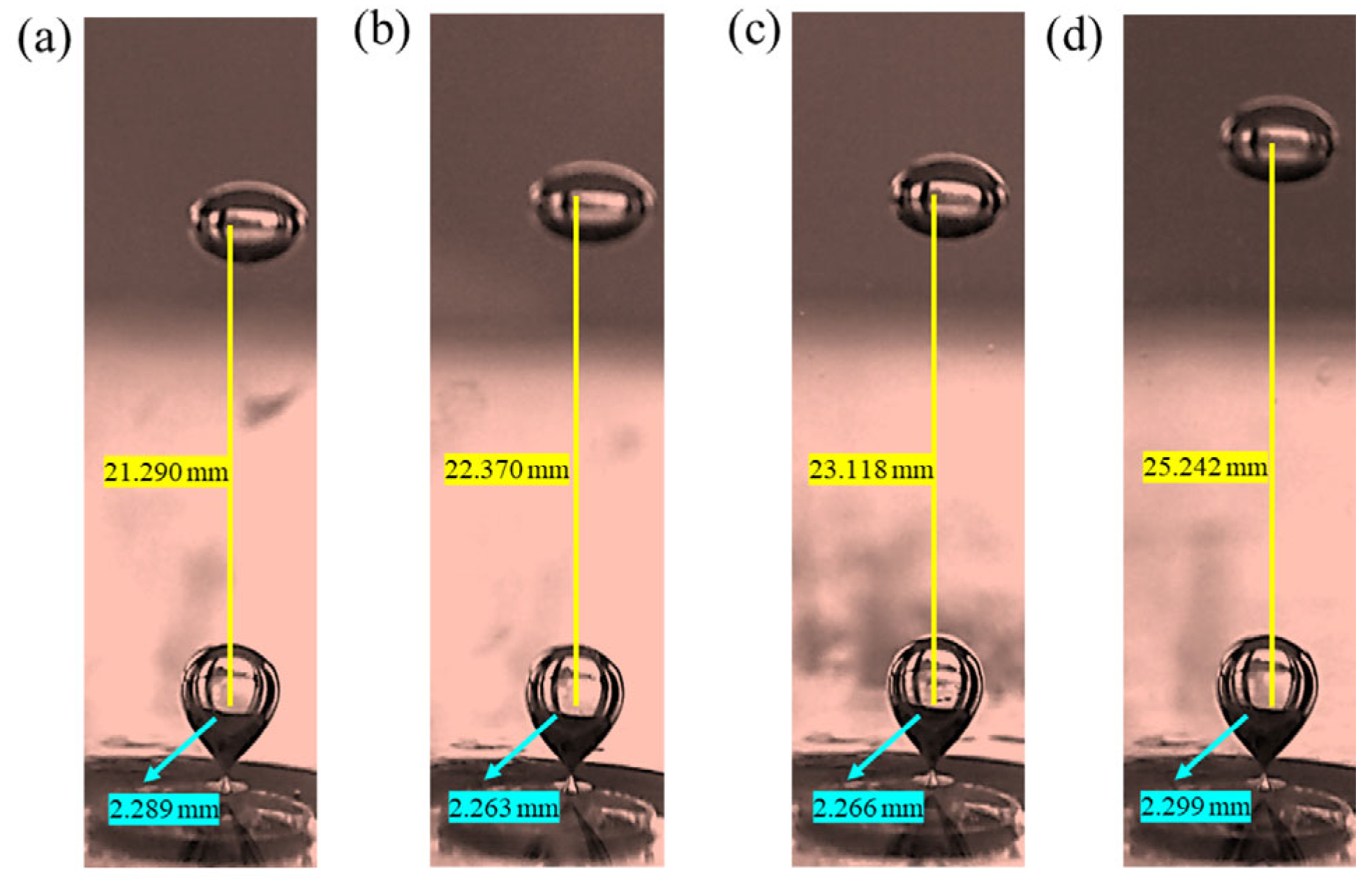
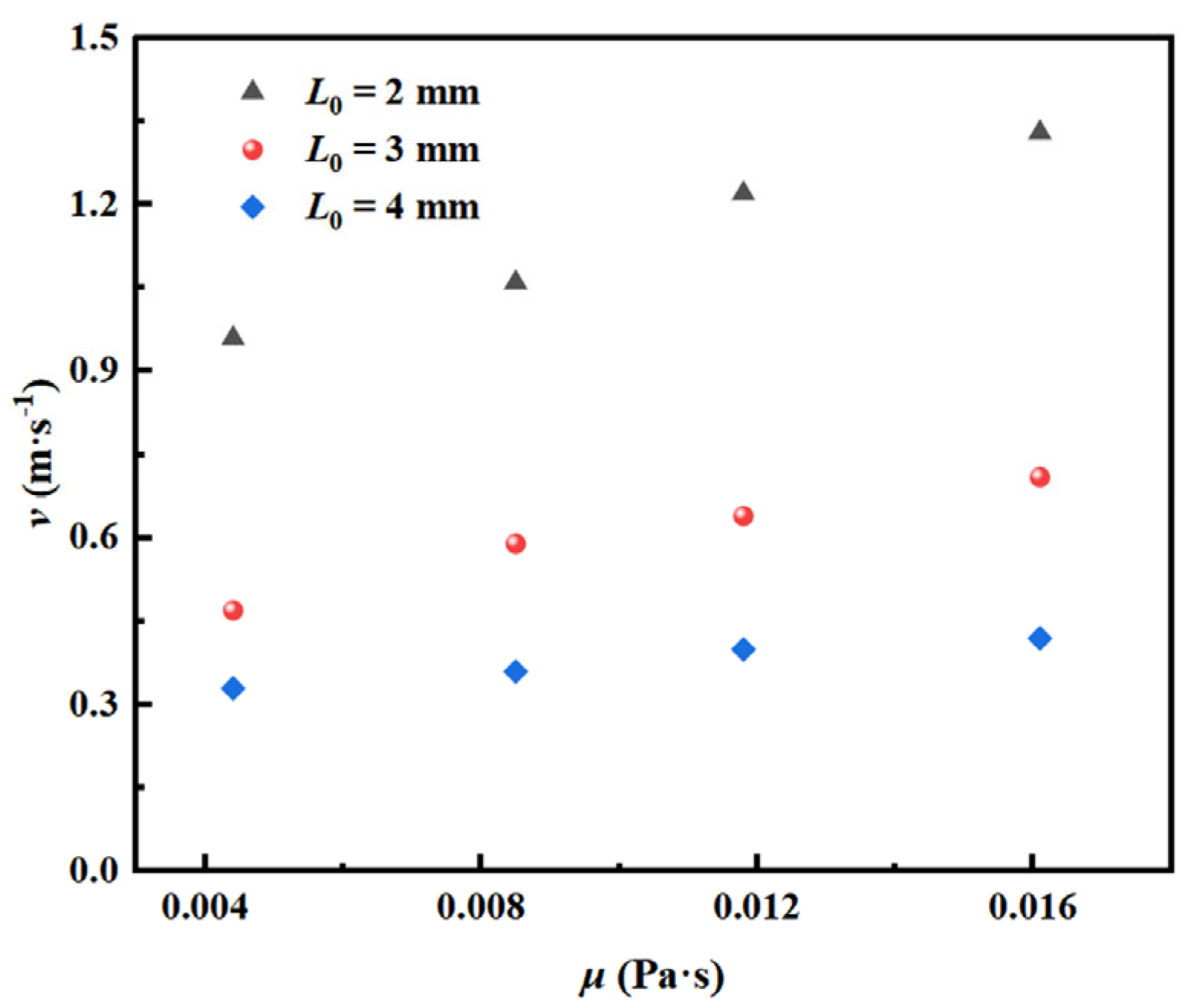
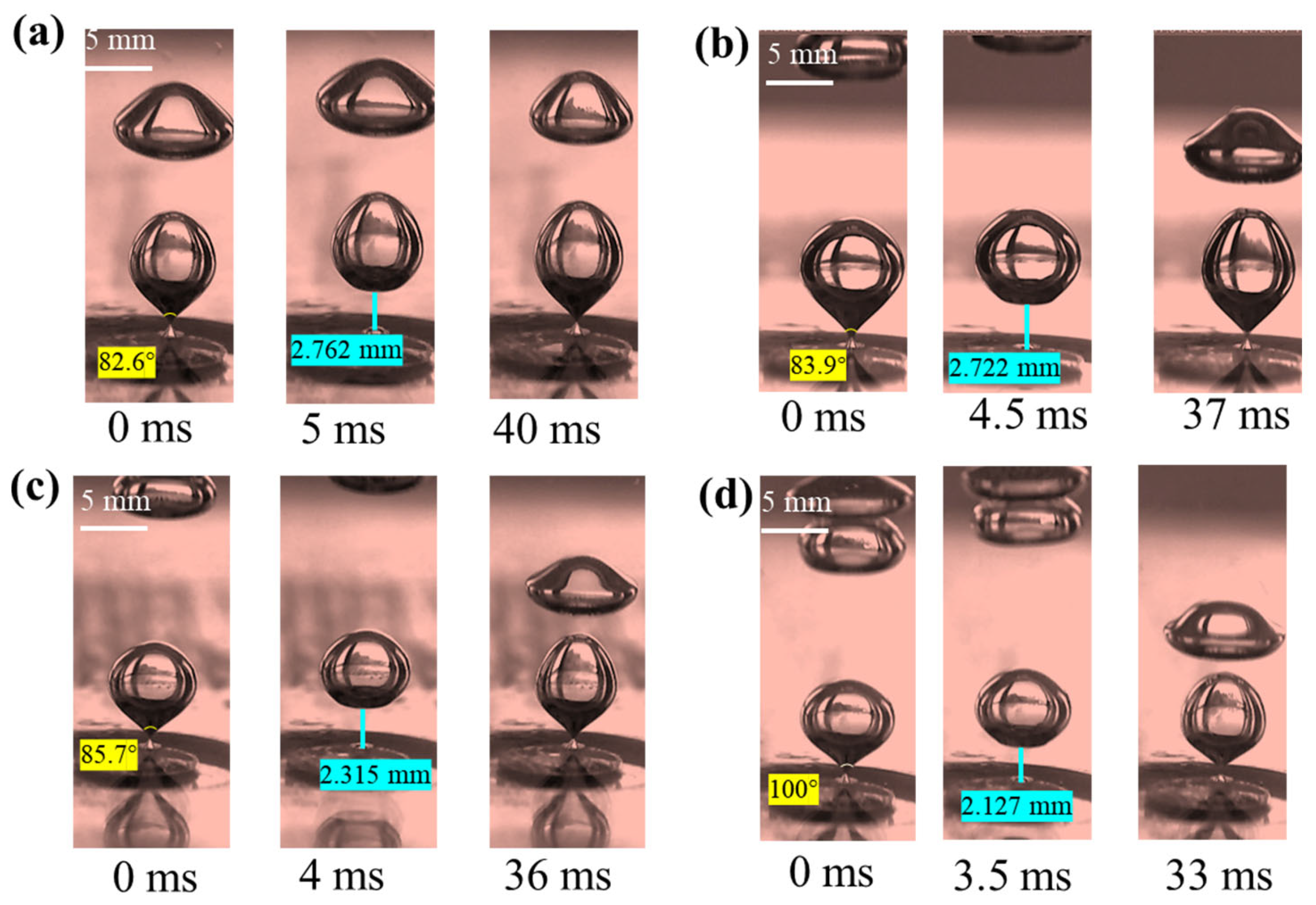
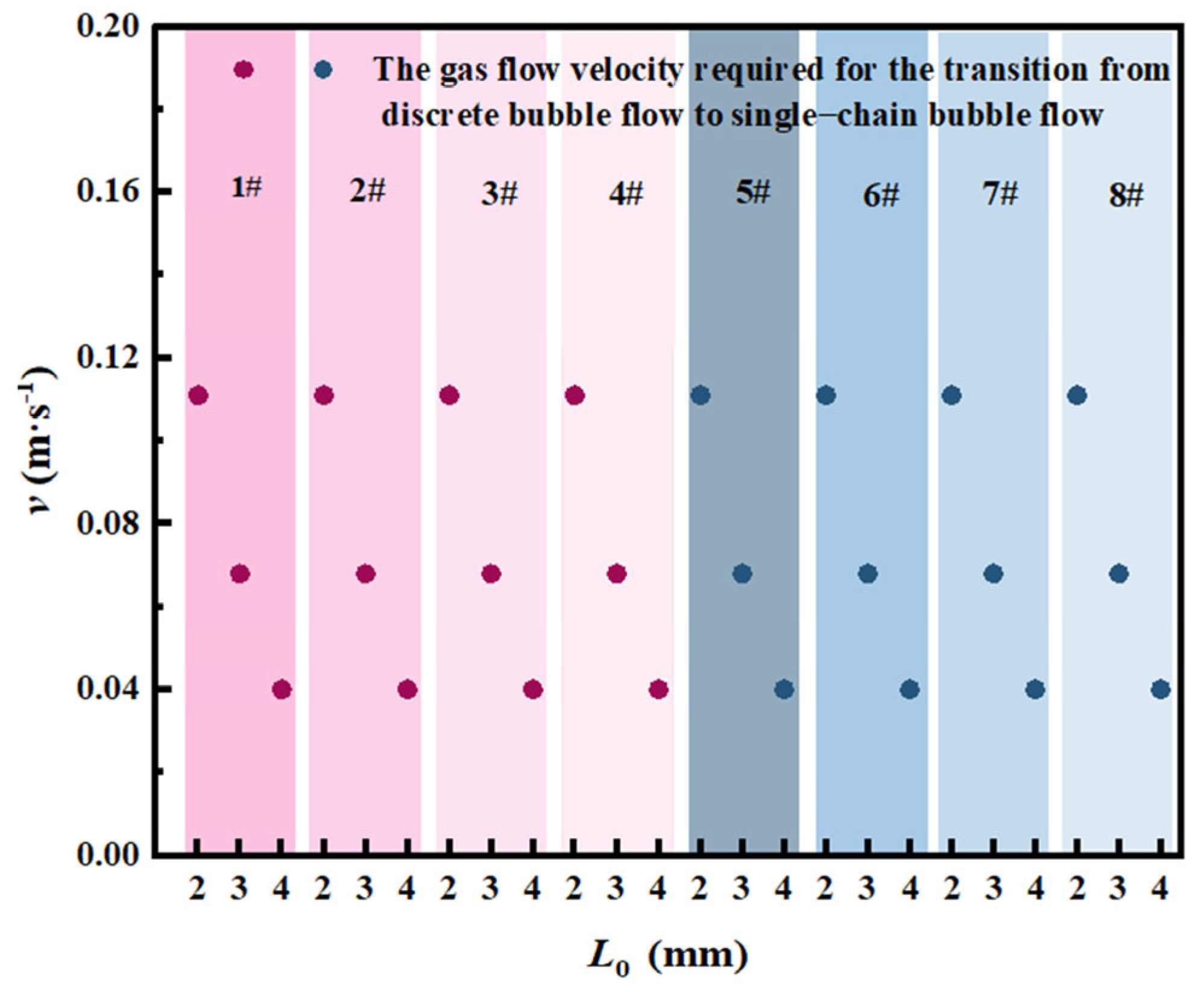




| Number | Mass Concentration (g·L−1) | Dynamic Viscosity (Pa·s) | Density (kg·m−3) | Surface Tension (N·m−1) |
|---|---|---|---|---|
| 1# | 0.001 | 0.00100 | 997 | 0.0700 |
| 2# | 0.169 | 0.00102 | 996 | 0.0595 |
| 3# | 0.369 | 0.00103 | 996 | 0.0507 |
| 4# | 0.653 | 0.00107 | 995 | 0.0399 |
| Number | Mass Concentration (g·L−1) | Dynamic Viscosity (Pa·s) | Density (kg·m−3) | Surface Tension (N·m−1) |
|---|---|---|---|---|
| 1# | 0.001 | 0.00100 | 997 | 0.0700 |
| 2# | 0.169 | 0.00102 | 996 | 0.0595 |
| 3# | 0.369 | 0.00103 | 996 | 0.0507 |
| 4# | 0.653 | 0.00107 | 995 | 0.0399 |
| Bubble Flow Patterns | Dominant Frequency | Dominant Frequency Range (Hz) | Spectrum Energy Distribution Characteristics |
|---|---|---|---|
| discrete bubble flow | natural frequency | 1100–1600 | 1100–1600 Hz (90%) |
| single-chain bubble flow | lowest resonance frequency | 760–1100 | 760–1000 Hz (85%) 1300–1600 Hz (5%) |
| dual-stage chain bubble flow | lowest resonance frequency | <760 | <760 (90%) |
Disclaimer/Publisher’s Note: The statements, opinions and data contained in all publications are solely those of the individual author(s) and contributor(s) and not of MDPI and/or the editor(s). MDPI and/or the editor(s) disclaim responsibility for any injury to people or property resulting from any ideas, methods, instructions or products referred to in the content. |
© 2025 by the authors. Licensee MDPI, Basel, Switzerland. This article is an open access article distributed under the terms and conditions of the Creative Commons Attribution (CC BY) license (https://creativecommons.org/licenses/by/4.0/).
Share and Cite
Zhou, W.; Yi, K.; Wang, G.; Wang, H. Classification of Acoustic Characteristics of Bubble Flow and Influencing Factors of Critical Gas Flow Velocity. Processes 2025, 13, 2055. https://doi.org/10.3390/pr13072055
Zhou W, Yi K, Wang G, Wang H. Classification of Acoustic Characteristics of Bubble Flow and Influencing Factors of Critical Gas Flow Velocity. Processes. 2025; 13(7):2055. https://doi.org/10.3390/pr13072055
Chicago/Turabian StyleZhou, Wenbin, Kunlong Yi, Guangyan Wang, and Honghai Wang. 2025. "Classification of Acoustic Characteristics of Bubble Flow and Influencing Factors of Critical Gas Flow Velocity" Processes 13, no. 7: 2055. https://doi.org/10.3390/pr13072055
APA StyleZhou, W., Yi, K., Wang, G., & Wang, H. (2025). Classification of Acoustic Characteristics of Bubble Flow and Influencing Factors of Critical Gas Flow Velocity. Processes, 13(7), 2055. https://doi.org/10.3390/pr13072055






